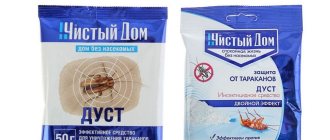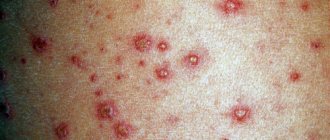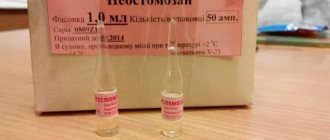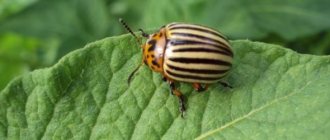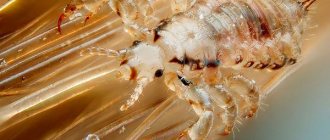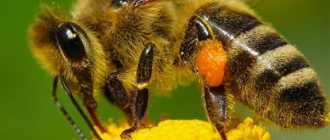Description, composition and release forms
In its pure form, chlorpyrifos is a crystallized white powder. The substance has a specific odor. It dissolves in water at a temperature of +250C and is completely destroyed in alkalis. The substance remains active on surfaces for 1-2 months, and when it gets into the soil – 120 days.
Chlorpyrifos is sold in the form of a solution, the concentration of which is 48%. The product is packaged in plastic containers of 1 l, 5 l, 25 l.
You can find other drugs based on this toxic substance on sale. They are available in the form of a liquid suspension. In addition to chlorpyrifos, the products also contain a second active ingredient – cypermethrin. This combination allows you to achieve maximum effectiveness against cockroaches and bedbugs.
Popular insecticidal preparations:
- Chlorpyrivit;
- Maxifos;
- Get;
- Agran;
- Sychlor;
- Sinuzan;
- Chlorpyrimark.
Products containing chlorpyrifos have a detrimental effect on cockroaches, bedbugs, ticks, flies, lice, and ants.
Get
Scientists and social activists criticized Chlorpyrifos
Clean Label Project experts spoke about the risks to human health posed by the rapidly growing popularity of the pesticide Chlorpyrifos and why it cannot become a full-fledged replacement for the more common glyphosate.
One of the most common pesticides in the world today remains the composition produced under the RoundUp brand. Its active ingredient glyphosate is excellent at controlling a wide range of weeds. It was registered as a pesticide back in 1974 - and still retains a significant share of the market for agricultural pesticides. However, glyphosate has come under widespread criticism in recent years due to its designation by the World Health Organization (WHO) as a "probable carcinogen".
In May 2021, a California court awarded more than $2 billion to a couple who claimed Bayer AG's glyphosate-based weed killer caused their cancer. To date, this is the largest verdict in any chemical litigation in American court practice.
Some lawyers argued that the settlement amount may not have been so impressive. However, this would be of little help to Bayer, which is currently in a state of legal crisis. In June of this year, it acquired Monsanto and its RoundUp brand for $63 billion - and in addition inherited the lawsuits brought against Monsanto (more than 13,000 cases).
However, claims against glyphosate are not limited to American shores. On September 4, 2021, Germany said it would gradually reduce its use of the controversial pesticide and phase it out completely by 2023.
Observing the regulatory, legal and consumer battle between the public and glyphosate, as well as the differences between the decisions of the official court and the court of public opinion, raises the natural question: “What next?” Are there other pesticides that are equally effective and at the same time safe for humans? Can existing risks be accepted?
Theoretically, such an alternative could be chlorpyrifos, which is an organophosphorus compound. Its key advantage lies in its complex action: it is an insecticide, an acaricide, and a miticide. It is mainly used to control weeds and soil-dwelling insect pests and is suitable for a variety of food and feed crops.
However, the possibility of using this pesticide is highly questionable. In August 2021, the European Food Safety Authority stated that no safe exposure level could be established for chlorpyrifos. This means the EU is unlikely to renew the authorization for chlorpyrifos after the current authorization expires in January next year. This decision by the European Commission goes against the policy of the US Environmental Protection Agency - in July 2021, the American agency said that it does not plan to ban chlorpyrifos.
Meanwhile, US consumer advocacy group Earthjustice has been campaigning for several years to ban chlorpyrifos due to its links to low birth weight, lower IQ, working memory loss, attention problems and delayed motor development in children. And under public pressure, the Environmental Protection Agency (EPA) revised its November 2021 assessment of the effects of chlorpyrifos on human health, confirming that there is not and cannot be a safe use standard for this pesticide.
Considering the above, it can be argued that the use of chlorpyrifos creates significant risks for the brand and may undermine consumer confidence. Despite the fact that at the moment there is no consensus among the world community regarding the possibility of using chlorpyrifos, American experts are confident that in the near future the demand for this pesticide will significantly decrease.
Mechanism of action on bedbugs and cockroaches
Chlorpyrifos has a contact effect. When a substance enters the body of an insect, it penetrates the body and blocks the enzyme responsible for transmitting nerve impulses from the brain to the muscles. This leads to paralysis and then death of the insect.
The advantage of drugs based on chlorpyrifos is that they have a delayed effect. Therefore, an infected individual, remaining active for some time, brings the poison to the nest, where it transmits it to its relatives. This leads to massive death of pests and parasites.
Chlorpyrifos destroys not only adults and larvae, but also oviposition. As a result, the offspring stops developing, and the protective shell gradually dries out. But to achieve such a result, direct contact of the egg with a toxic substance is necessary.
Application
Before using chlorpyrifos-based preparations against bedbugs or cockroaches, you must first prepare the room. To do this, it is necessary to move furniture away to open access to possible places where insects are localized, remove animals from the premises, remove indoor plants, and pack food in sealed plastic containers.
After the preparatory measures, you should wet clean the room and put mesh or gauze plugs on the ventilation grilles so that the pests do not move to the neighbors.
Disinsection should be carried out with the windows open. According to the instructions, it is necessary to prepare a working solution based on chlorpyrifos. To do this, you need to dilute 50 ml of emulsion in 10 liters of water, the temperature of which should be above +250C.
Spray the solution at a distance of 30 cm from the surface. When using bedbug repellent, upholstered furniture and beds should be thoroughly treated. Pay special attention to folds, seams and junctions of individual elements. And also spray the solution on the back of paintings, loose wallpaper, and into the cracks on the walls.
Argan
When using chlorpyrifos against cockroaches, the concentration of the working solution should be increased to 60 ml per 10 liters of water. It is necessary to treat baseboards, adjacent areas of walls and floors, pipe entry points in the kitchen, bathroom and toilet, the back surface of cabinets, the area under the sink and near the trash can.
After treating the windows and doors, you need to close and leave the room for 7-14 days. After the waiting period has expired, it is necessary to ventilate the room, vacuum the furniture, soft toys, carpets, and wash all surfaces in the house with a soap solution containing soda. When the number of pests and parasites is small, one treatment with chlorpyrifos is sufficient. But if necessary, disinfestation should be repeated after 2 weeks, which will achieve maximum effectiveness.
Security measures
This organophosphate insecticide belongs to hazard class 2. Harm to humans from chlorpyrifos can be caused by failure to comply with precautions and exceeding the permissible dosage of the drug. In this case, speech impairment, dizziness, confusion, vomiting, stomach cramps, muscle tremors, and lacrimation are observed.
Poisoning occurs when inhaling harmful fumes, as well as in the case of prolonged contact of the insecticide with the skin, which leads to disruption of neuromuscular connections.
If alarming symptoms appear, you should immediately leave the room, take activated carbon at the rate of 1 tablet per 10 kg of body weight, wash it down with plenty of water. If your health worsens further, you should seek medical help.
To avoid negative health effects, only one person should be in the room during processing. He must carry out all manipulations with the drug in special clothing, a respirator and rubber gloves. Avoid contact of the working solution with exposed areas and mucous membranes. If this happens, you need to rinse off the product under running water.
After disinfestation, you should thoroughly wash your hands with soap, take a shower and wash your overalls.
Chlorpyrifos - instructions you must read
The effects of the drugs last for one to two months. In the soil, chemical compounds persist for up to 120 days. However, some experts express the opinion that the drug is stable for two years. You should be prepared for the fact that if you regularly use this chemical to treat a certain area, some insects may develop group resistance.
Nowadays, a wide range of chlorpyrifos poisons are produced for agriculture. Pay attention to whether the drugs you purchase have been registered. As practice shows, certified products are really effectively used against sucking and gnawing types of pests that occur, for example, in sugar beets - these are leaf aphids, flea beetles, meadow moths, common beet weevils, cutworms, cutworms or carrion beetles.
Chlorpyrifos is classified as a moderately hazardous substance, hazard class 3. When used correctly, it does not harm the environment, human health, or animals. Maximum efficiency is maintained for 2 hours; under the influence of sunlight, air temperature is gradually destroyed. The substance is deadly to any insects, fish, and amphibians. Should be used when particularly necessary; do not use in reservoirs with fish or frogs.
Contact with human skin causes irritation and an allergic reaction. Manifests itself in the form of redness, rash, swelling, itching, burning. In most cases, it goes away on its own within 2-3 days. If you are prone to allergies, special treatment with antihistamines and antiallergic ointments is required.
Penetration of Chlorpyrimarc into the respiratory tract and stomach, poisoning of varying degrees of intensity is observed. Weakness, headache, dizziness, nausea, diarrhea, rapid heartbeat, pallor and other signs of intoxication appear.
In animals, Chlorpyrimark causes increased salivation, lacrimation, allergies, nausea, vomiting, diarrhea, muscle weakness, sleep disturbance, and tremors. Symptoms disappear within 1-3 days. If a significant dose of poison enters the stomach, the help of a specialist is required.
Read also: Where do tits live in summer?
